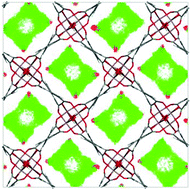Confined methanol within InOF-1: CO2 capture enhancement†
Abstract
The CO2 capture performance of InOF-1 was optimised by confining small amounts of MeOH within its micropores (MeOH@InOF-1). In comparison with fully activated InOF-1, MeOH@InOF-1 shows a 1.30 and 4.88-fold increase in CO2 capture capacity for kinetic and static isothermal CO2 adsorption experiments respectively. Density functional theory calculations coupled with forcefield based-Monte Carlo simulations revealed that such an enhancement is assigned to an increase of the degree of confinement felt by the CO2 molecules resulting from the formation of a lump at the vicinity of the μ2-OH groups since MeOH strongly interacts with these adsorption sites and is thus highly localized in this region.



 Please wait while we load your content...
Please wait while we load your content...